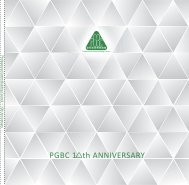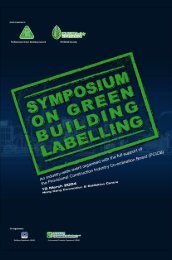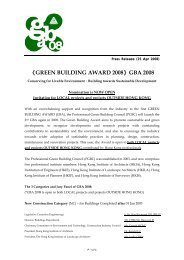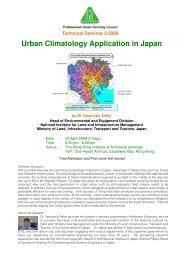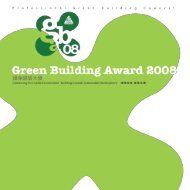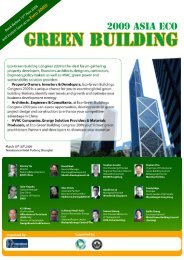Paper - The Professional Green Building Council
Paper - The Professional Green Building Council
Paper - The Professional Green Building Council
You also want an ePaper? Increase the reach of your titles
YUMPU automatically turns print PDFs into web optimized ePapers that Google loves.
SB07HK – Sustainable <strong>Building</strong> Conference Hong Kong, 4-5 December 2007<br />
accuracy and reliability of assessment results are also<br />
rising.<br />
Simultaneously, this creates a pressure of summarising<br />
complex data and relationships in highly aggregated<br />
format for decision makers. Thus, the scientific<br />
community is challenged to develop approaches and<br />
solutions for hitherto dissatisfactory solved questions.<br />
In the area of assessing the environmental quality<br />
of construction works a clear trend towards using life<br />
cycle assessments (LCA) as one of the underlying<br />
bases. However, despite a number of published<br />
works on this issue (see for example [28],[29]) no<br />
satisfactory solution for the weighting and aggregation<br />
of impacts on the environment has yet been found. In<br />
addition, generally acceptable solutions to questions<br />
concerning the combined assessment of the cumulated<br />
mass flow (in the sense of assessing the use of<br />
different materials) as well as concerning the sealing<br />
and conversion of land as partial aspects of resource<br />
use have not yet been found.<br />
In the area of assessing the economic efficiency<br />
of construction works life cycle costing approaches<br />
became widely accepted. <strong>The</strong> methodological basis<br />
for this has been developed and discussed within<br />
large scale EU projects [30]. However, the following<br />
issues deserve further research and clarification: assumptions<br />
on the life expectancy of building products,<br />
components and systems as well as the choice of an<br />
appropriate discount rate for converting future expenses.<br />
Regarding the latter issue it is indeed questionable<br />
if the methods of investment and economic<br />
efficiency analysis (which are usually considered appropriate<br />
for time horizons between 10 and 20 years)<br />
are applicable to buildings with life expectancies of 80<br />
years and more. From the author’s point of view approaches<br />
of a ‘long term economy’ have to be developed<br />
and investigated for the building and construction<br />
sector. Furthermore, research is necessary to<br />
extend contemporary life cycle costing approaches by<br />
assessing and monetising property specific chances<br />
and risks. In addition, within the scope of further developing<br />
of the life-cycle costing approaches towards<br />
Whole Life Costing [31] issues of property income<br />
and development of property value and/or worth have<br />
to be taken into account as well. In particular the investigation<br />
of the relationships between the sustainability/quality<br />
of buildings and the stability and/or development<br />
of their market value deserves further attention<br />
[32].<br />
Concerning the social dimension of sustainable<br />
development there is still not yet consensus on how<br />
to translate and adjust wider societal goals and concerns<br />
to the assessment and evaluation of single<br />
buildings. It is now widely accepted that impacts on<br />
health and comfort of building occupants have to be<br />
analysed and that impacts on occupant/employee<br />
satisfaction have to be investigated through post occupancy<br />
evaluations during the operating phase. Also<br />
investigations into the relationships between occupant<br />
comfort and productivity have gained acceptance; see<br />
for example [33]. Nonetheless, there exists a great<br />
need for research work to develop a methodology for<br />
a highly aggregated description of occupant satisfaction<br />
as well as to investigate the interrelation between<br />
occupant satisfaction and issues like vacancy risk.<br />
Finally, questions on how to describe, assess and<br />
integrate the aesthetic and urban design quality as<br />
well as the cultural value of buildings within an overall<br />
assessment are far from being satisfactorily solved.<br />
5. Summary and outlook<br />
Implementing the principles of sustainable development<br />
in the construction sector requires a much<br />
closer orientation and focus on the interests and decision<br />
making processes of the major actors concerned.<br />
<strong>The</strong>se actors – such as governmental authorities,<br />
banks, investors, insurance agencies and their professional<br />
advisors – increasingly demand for reliable<br />
sustainability assessment results in order to obtain an<br />
additional informational basis for decision making. As<br />
consequence, assessment methods and tools are to<br />
be further developed towards improved applicability<br />
and reliability as well as greater consensus. Particularly<br />
the standardisation activities coordinated by ISO<br />
provide a substantial contribution to safeguarding<br />
consensus of assessment methods and procedures.<br />
For this reason, stronger engagement of Asian countries<br />
within these standardisation activities would be<br />
highly desirable, also in order to learn more about<br />
these countries’ requirements and experiences made<br />
in the area of sustainable building.<br />
Besides an increased focus on market driven approaches<br />
(‘sustainability as a competitive factor’) for<br />
further advancing the transformation of property and<br />
construction markets there also exists a strong trend<br />
towards setting an appropriate framework (legislation,<br />
taxation, subsidy programs, etc.) for sustainable construction.<br />
Within European countries a number of<br />
positive experiences have been made on how market<br />
forces and governmental intervention can mutually<br />
reinforce and complement each other in pursuit of<br />
more sustainable construction.<br />
As outlined above providing solutions and answers<br />
to still existing problems and questions presents<br />
a great challenge for the international scientific<br />
community. However, this opens up various possibilities<br />
for researchers from Asia and Europe to intensify<br />
collaboration as well as knowledge and experience<br />
transfer – especially in response to an increased<br />
globalisation or property markets which also always<br />
requires paying attention to regional traditions and<br />
particularities.<br />
ACKNOWLEDGEMENT<br />
<strong>The</strong> author thanks Dr. David Lorenz for providing<br />
assistance in producing this paper.



